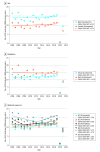Sociodemographic Factors and Trends in Bronchiolitis-Related Emergency Department Visit and Hospitalization Rates
- PMID: 38683605
- PMCID: PMC11059049
- DOI: 10.1001/jamanetworkopen.2024.8976
Sociodemographic Factors and Trends in Bronchiolitis-Related Emergency Department Visit and Hospitalization Rates
Abstract
Importance: Bronchiolitis is the most common and most cumulatively expensive condition in pediatric hospital care. Few population-based studies have examined health inequalities in bronchiolitis outcomes over time.
Objective: To examine trends in bronchiolitis-related emergency department (ED) visit and hospitalization rates by sociodemographic factors in a universally funded health care system.
Design, setting, and participants: This repeated cross-sectional cohort study was performed from April 1, 2004, to March 31, 2022, using population-based health administrative data from children younger than 2 years in Ontario, Canada.
Main outcome and measures: Bronchiolitis ED visit and hospitalization rates per 1000 person-years reported for the equity stratifiers of sex, residence location (rural vs urban), and material resources quintile. Trends in annual rates by equity stratifiers were analyzed using joinpoint regression and estimating the average annual percentage change (AAPC) with 95% CI and the absolute difference in AAPC with 95% CI from April 1, 2004, to March 31, 2020.
Results: Of 2 921 573 children included in the study, 1 422 088 (48.7%) were female and 2 619 139 (89.6%) lived in an urban location. Emergency department visit and hospitalization rates were highest for boys, those with rural residence, and those with least material resources. There were no significant between-group absolute differences in the AAPC in ED visits per 1000 person-years by sex (female vs male; 0.22; 95% CI, -0.92 to 1.35; P = .71), residence (rural vs urban; -0.31; 95% CI -1.70 to 1.09; P = .67), or material resources (quintile 5 vs 1; -1.17; 95% CI, -2.57 to 0.22; P = .10). Similarly, there were no significant between-group absolute differences in the AAPC in hospitalizations per 1000 person-years by sex (female vs male; 0.53; 95% CI, -1.11 to 2.17; P = .53), residence (rural vs urban; -0.62; 95% CI, -2.63 to 1.40; P = .55), or material resources (quintile 5 vs 1; -0.93; 95% CI -3.80 to 1.93; P = .52).
Conclusions and relevance: In this population-based cohort study of children in a universally funded health care system, inequalities in bronchiolitis ED visit and hospitalization rates did not improve over time.
Conflict of interest statement
Figures


Similar articles
-
Trends in Emergency Department Use by Rural and Urban Populations in the United States.JAMA Netw Open. 2019 Apr 5;2(4):e191919. doi: 10.1001/jamanetworkopen.2019.1919. JAMA Netw Open. 2019. PMID: 30977849 Free PMC article.
-
Rates in Bronchiolitis Hospitalization, Intensive Care Unit Use, Mortality, and Costs From 2004 to 2018.JAMA Pediatr. 2022 Mar 1;176(3):270-279. doi: 10.1001/jamapediatrics.2021.5177. JAMA Pediatr. 2022. PMID: 34928313 Free PMC article.
-
Longitudinal healthcare use after pediatric brain injury: A population-based birth cohort study.PLoS One. 2025 Feb 24;20(2):e0316165. doi: 10.1371/journal.pone.0316165. eCollection 2025. PLoS One. 2025. PMID: 39992895 Free PMC article.
-
Trends in emergency department visits for bronchiolitis, 1993-2019.Pediatr Pulmonol. 2024 Apr;59(4):930-937. doi: 10.1002/ppul.26851. Epub 2024 Jan 12. Pediatr Pulmonol. 2024. PMID: 38214423 Free PMC article. Review.
-
Bronchiolitis in US emergency departments 1992 to 2000: epidemiology and practice variation.Pediatr Emerg Care. 2005 Apr;21(4):242-7. doi: 10.1097/01.pec.0000161469.19841.86. Pediatr Emerg Care. 2005. PMID: 15824683
Cited by
-
Effectiveness of nirsevimab in reducing hospitalizations in emergency departments due to bronchiolitis among infants under 3 months: a retrospective study.Eur J Pediatr. 2025 Mar 5;184(3):229. doi: 10.1007/s00431-025-06050-7. Eur J Pediatr. 2025. PMID: 40044918
References
-
- Public Health Agency of Canada (PHAC) . Reducing Health Inequalities: A Challenge For Our Times. Accessed November 22, 2023. https://publications.gc.ca/collections/collection_2012/aspc-phac/HP35-22...
-
- World Health Organization . Health Impact Assessment, Glossary of Terms. Accessed November 18, 2023. https://www.who.int/docs/default-source/documents/publications/glossary-...
Publication types
MeSH terms
LinkOut - more resources
Full Text Sources
Miscellaneous

